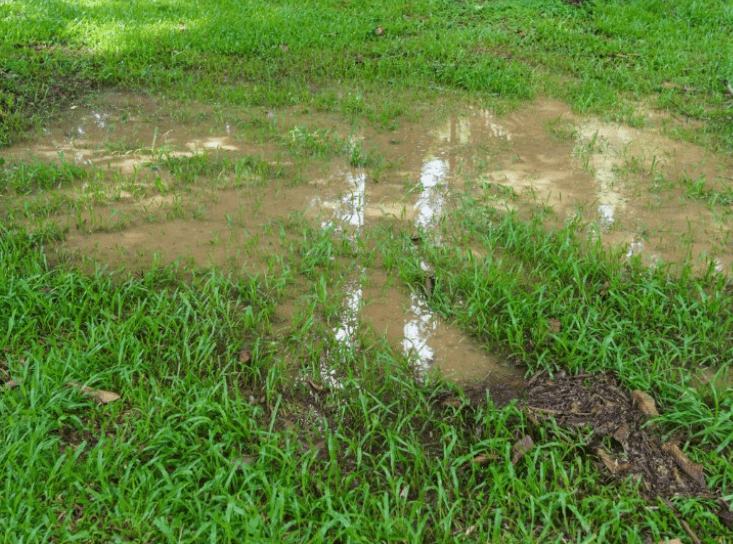Standing water in yard after rain or watering will automatically lead to a number of problems. From breeding mosquitoes to muddying your house. Your lawn will also become progressively worse as pests, fungi and diseases strike.
This should make you establish how to soak up water in backyard fast. Before that lets find out the reasons for water flooding in the yard.
Standing Water in Yard Causes
The following are reasons for standing water in your yard:
1. Soil compaction
Soil compaction happens when there are no more air spaces and pores between soil grains. This may be as a result of too much pressure on the soil or too much clay particles. Compacted soil becomes unable to absorb or drain water thus causing flooding, surface runoff and even erosion.
2. Thatch Build-up
Thatch forms when undecomposed layer of organic matter is formed in your turf. A thick layer of thatch not only inhibits nutrients and oxygen from reaching grass roots, it also stops water from draining into the soil. After a heavy downpour, presence of thatch in your lawn may lead to water standing in your backyard.
3. Low spots
If your property lies on the sloping end of a terrain, then water will be your frequent guest. Uneven landscape or lawn may also present low spot areas that acts as water catchments. Low spots notoriously attract flooding irrespective of the soil type. During or after raining the runoff water will always move towards your low laying area.
4. Blocked drainage system
Drainage systems are important parts of landscaping. They help in removing surface or sub-surface water from a given area. A blocked drainage system may be the reason for that standing water in your yard. Blockage in the exterior drainage systems is usually caused by build-up of debris, silt, twigs and leaves.
5. Water saturation
A water saturated soil cannot absorb any more of it. This is common during a heavy rainy season or uncontrolled watering of a lawn or garden. Without a proper drainage system, you will find plenty of water pooling in your backyard.

How to Fix the Problem of Standing Water Yard
Removing standing water in yard early enough can be beneficial to your garden, lawn and family. There will be no more mosquitos and your flowers and grass will start recovering. Here is how to fix water drainage problems in yard fast:
1. Reduce watering
If water pools in your backyard after watering a lawn, flower or vegetable garden, think about taking a break. Study how long the present water will take to disappear before embarking on any extensive drainage project. You may realize that your watering schedule could be the reason for the puddles.
2. Aerate the yard
Flooding caused by thatch build-up or compacted soil can be solved by aeration. Removing thatch and punching small holes into the turf or soil can help loosen the soil and allow water to drain or get absorbed by the grass roots. There are special tools for aeration you will need such as folk, core and plug aerator.
3. Fix your drainage system
Check and remove debris and silt from the nearby exterior drainage systems. You may use a shovel to scope out the materials that are causing the blockage. Also consider diverting the runoff away from your backyard if the flooding is caused by a gutter system. Direct them into a storm drain or other safe drainage source and not towards neighboring property.
4. Dig a Creek Bed
Digging a creek can help fix water drainage problem in yard. It involves digging a long shallow trench into the soil and filling it with small decorative rocks or gravel. The drainage swale will therefore lead rainwater to a storm drain. A well-constructed creek also adds attractive feature to a landscape.
5. French Drain and/or dry well
Problem of standing water in a yard can be solved by installation of a French drain and dry well. Water runs into a gravel filled trench then into a perforated pipe at the bottom of the trench and finally into a dry well or drainage source.
A dry well usually fitted at the end point of a creek or French drain collects and disperse water into the surrounding soil. It is usually perforated on the side walls and best placed in an area where the soil drains well.
6. Install underground drainage pipe
An underground drainage pipe can be installed to drain water from your yard to a storm drain or dry well. The pipe should slope downhill or towards a lower area than your yard. This is an easier method of drying up a wet yard.
Simply dig a gradually sloping trench from the source to outlet and burry a PVC drainpipe. Install a plastic catch basin at the source and let the water smoothly move away from a yard.
7. Level your lawn
Uneven lawn can lead to water pooling in your yard. You should level your bumpy or uneven lawn so that water can flow or distribute evenly once it rains.
Final thought
Getting rid of standing water in yard can call for different DIY approaches depending on the real reason behind the problem. If you find it overwhelming, it will be good to contract an expert. Do not let your outdoor beauty and investments be ruined by standing water. Be on the watch out and take a control measure early enough.